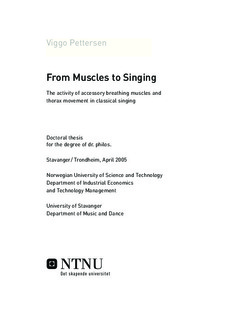| dc.contributor.author | Pettersen, Viggo | nb_NO |
| dc.date.accessioned | 2014-12-19T14:24:49Z | |
| dc.date.available | 2014-12-19T14:24:49Z | |
| dc.date.created | 2005-04-29 | nb_NO |
| dc.date.issued | 2005 | nb_NO |
| dc.identifier | 125600 | nb_NO |
| dc.identifier.isbn | 82-471-7063-9 | nb_NO |
| dc.identifier.uri | http://hdl.handle.net/11250/264991 | |
| dc.description.abstract | The overall aim of the present studies was, in selected muscles, to investigate muscle activation levels and muscular patterns in classical singers. Further was these muscles’ relation to thorax movement investigated.
Loading levels and respiratory phasing of TR, STM and SC was investigated in vocalization tasks with high and moderate expiration. Further, PN activity was investigated in inhalation and phonation and finally, TR, INT, OBL and RC muscle loading in student and professional singers was examined.
Muscle activity was recorded by use of an ambulatory four-channel monitoring system (Physiometer PHY 400, Premed, Norway). TX movement pattern was traced with two strain gauge sensors (RES-117) placed around the upper TX and lower TX .
A phasing of upper TR activity to INT and OBL activity was discovered, all muscles supporting the expiration phase. During phonation TR contributes in the compression of the upper TX, thus serving as an accessory muscle of expiration. TR activity is reduced with short breathing cycles and is mostly inactive in simplified speaking tasks During phonation professional opera singers activate the expiratory phased TR, INT, OBL and RC muscles to higher levels than student singers do.
STM and SC show correlated activity patterns during inhalation and phonation by classical singers. During demanding singing expiratory phased STM and SC activity peaks produce a counterforce to the compression of upper TX at high pitches. As breathing demands are lowered STM and SC activity are reduced and attain inspiratory phasing. Substantial muscle activity is observed in posterior neck muscles (PN) during inhalation and phonation. EMG biofeedback performed on TR and STM have a secondary effect of lowering EMG activity in PN. | nb_NO |
| dc.language | eng | nb_NO |
| dc.publisher | Fakultet for samfunnsvitenskap og teknologiledelse | nb_NO |
| dc.relation.ispartofseries | Doktoravhandlinger ved NTNU, 1503-8181; 2005:94 | nb_NO |
| dc.relation.haspart | Pettersen, V; Westgaard, RH. Muscle activity in the classical singer’s shoulder and neck region. Logopedics Phoniatrics Vocology. 27: 169-178, 2002. | nb_NO |
| dc.relation.haspart | Pettersen, V; Westgaard, RH. The association between upper trapezius activity and thorax movement in classical singing. J. Voice. 18(4): 500-512, 2004. | nb_NO |
| dc.relation.haspart | Pettersen, V; Westgaard, RH. The Activity Patterns of Neck Muscles in Professional Classical Singing. J. Voice. 19(2): 238-251, 2005. | nb_NO |
| dc.relation.haspart | Pettersen, V; Westgaard, RH. Muscle activity in professional classical singing: a study on muscles in the shoulder, neck and trunk. Logopedics Phoniatrics Vocology. 29(2): 56-65, 2004. | nb_NO |
| dc.relation.haspart | Pettersen, V. Some aspects of characterizing muscle activity levels in the neck and shoulder region by classical singers and classical pianists. ISME, 2004. | nb_NO |
| dc.subject | Musicology | en_GB |
| dc.subject | HUMANITIES and RELIGION: Aesthetic subjects: Music | en_GB |
| dc.title | From Muscles to Singing - The activity of accessory breathing muscles and thorax movement in classical singing | nb_NO |
| dc.type | Doctoral thesis | nb_NO |
| dc.contributor.department | Norges teknisk-naturvitenskapelige universitet, Fakultet for samfunnsvitenskap og teknologiledelse | nb_NO |
| dc.description.degree | Dr.philos. | nb_NO |
| dc.description.degree | Dr.philos. | en_GB |
